Page 881 - Problem-Based Feline Medicine
P. 881
40 – THE CAT WITH ANISOCORIA OR ABNORMALLY DILATED OR CONSTRICTED PUPILS 873
TOXICITY
● Toxins* (p 887)
Toxins that interrupt parasympathetic nerve transmission or stimulate sympathetic nervous
impulses can result in mydriasis. Bites from Elapid (cobra type) snakes often result in mydriasis.
Often there are diffuse clinical signs present including weakness, ataxia and prolonged bleeding
from venipuncture sites. Fluoroquirolone toxicity may result in a sudden onset of bilaterally
dilated, non-responsive pupils. Historical information regarding exposure to these toxins is impor-
tant to elucidate.
● Parasympatholytic drugs (p 888)
Dilated pupils are most commonly seen following either systemic or topical administration of
atropine. With systemic administration tachycardia is often also present. Historical administration
of or exposure to these drugs is an important clue.
INTRODUCTION ● The impulse then descends through the brain stem
and cervical spinal cord in the lateral tectotegmen-
tal spinal pathway.
MECHANISM?
● This upper motor neuron (UMN) pathway
Diseases that affect the iris muscle, other ocular struc- synapses on the cell bodies of the preganglionic
tures, the visual pathways, the nervous system innerva- sympathetic nerves located in the intermediolateral
tion to the iris, or systemic autonomic nervous system horns in the T 1–3 spinal cord segments.
functions may result in pupillary abnormalities. ● The preganglionic sympathetic nerves exit the
spinal cord and run cranially in the cervical sympa-
Mechanical abnormalities of the iris such as synechia
thetic trunk in the cranial thorax.
and iris atrophy are commonly associated with anisocoria.
● This pathway continues through the cervical
Abnormalities in the parasympathetic or sympa- area with the vagus nerve forming the vagosympa-
thetic input to the eye often are associated with abnor- thetic trunk.
mal pupil size. ● The preganglionic nerves synapse in the cranial
cervical ganglion located just caudal to the ear.
Intraocular causes of aniscoria are covered in The Cat
The postganglionic nerves run through the mid-
With Abnormal Pupil Size, Shape or Response
dle ear, course with cranial nerve (CN) IX (glos-
(page 1287) and The Cat With Abnormal Iris Appearance
sopharyngeal nerve) and then with the carotid
(page 1292).
artery to enter the skull.
● These nerves then course in the cavernous sinus
WHERE?
with the carotid artery, and exit the skull through
Disease of the eye, the visual pathways, or the path- the orbital fissure.
ways innervating the pupil may result in anisocoria. ● The postganglionic sympathetic fibers travel with
the ophthalmic branch of CN V (trigeminal nerve)
The visual pathway includes the retina, optic nerve,
to the eye and via the short ciliary nerve synapse on
optic chiasm, optic tract, lateral geniculate body, optic
the dilator muscle of the pupil.
radiations and the occipital cortex.
● Some postganglionic fibers innervate the smooth
Sympathetic innervation to the pupil is responsible muscle fibers in the orbital sheath (musculus
for pupillary dilation and innervation to the vessels of orbitalis).
the iris (Figure 40.1). ● Sympathetic innervation to eye includes the mus-
● Sympathetic control is initiated in the hypothala- cle of the periorbita, eyelids (Muller’s muscle), the
mus of the diencephalon. third eyelid, the dilator muscle of the iris, and the

